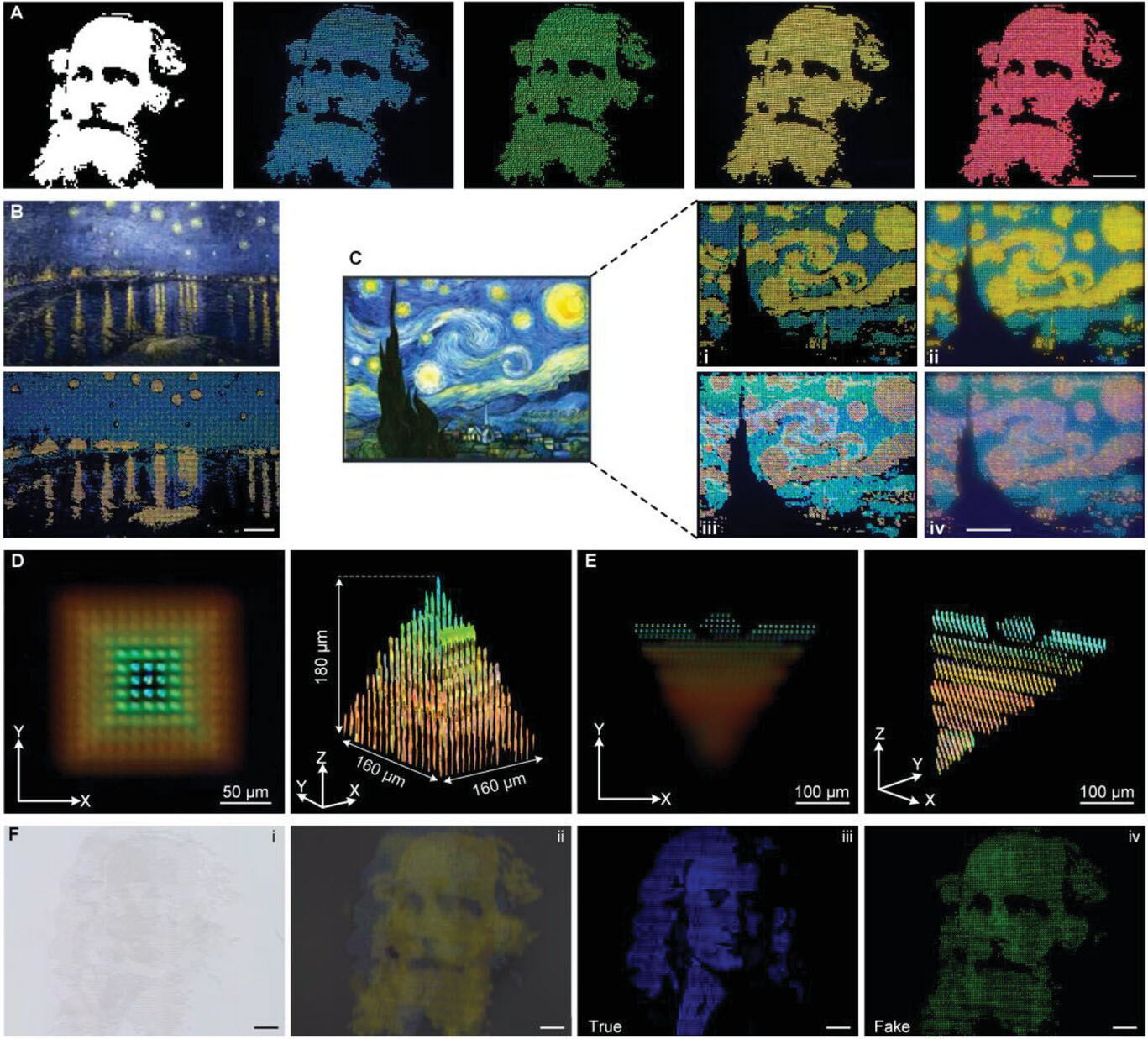| Oct 22, 2023 | |
From pixel to voxel: New technique creates vivid 3D color patterns inside clear glass |
|
| (Nanowerk Spotlight) For centuries, scientists have marveled at the brilliant and intricate structural colors found in nature, from peacock feathers to butterfly wings. These striking hues arise not from pigments, but from the physical interaction of light with nano-scale structural features. Scientists have long sought to replicate such structural colors artificially for a range of applications from anti-counterfeiting to ultra-high density data storage. | |
| However, previous efforts at engineered structural colors have been limited to two-dimensional surfaces or required complex 3D photonic crystal structures. Now, researchers from Zhejiang University in China have developed a groundbreaking new technique that allows for the first time to imprint high-resolution, full-color 3D voxel arrays throughout the bulk of transparent solids. | |
| A voxel is a unit of graphic information that represents a value in a three-dimensional grid. The term "voxel" is a portmanteau of "volume" and "pixel," where a pixel is the smallest unit of a 2D image. Just as a pixel has a specific location and value in a two-dimensional grid, a voxel exists at a particular point in a 3D space and contains data about that point. Voxels are used in a range of applications, including 3D graphics, medical imaging, and increasingly in data storage and other technological advancements. They can be thought of as the 3D equivalent of pixels. | |
| Published in Advanced Materials ("3D Imprinting of Voxel-Level Structural Colors in Lithium Niobate Crystal"), the new technique termed “micro-amorphization coloration” (MA) relies on the interaction of ordinary and extraordinary light waves inside uniaxial crystals. | |
 |
|
| Cross-dimension imprinting of exquisite micro-amorphization (MA)-color images. A) The designed grayscale and experimental monochromatic images of a portrait of Maxwell. B) Complicated chromatic picture patterning. Designed model (top) and experimental result (bottom). C) Voxel-level color tone tuning of a chromatic picture in both transmission mode (i, iii) and reflection mode (ii,iv). Designed model (left) and experimental results (right). Scale bars: (A) to (C), 200 µm. D,E) 3D chromatic patterning of MA colors, including basic geometry (D) and customized geometry (E). F) Optical information encryption where voxels with different color responses are superimposed together and indistinguishable by using white light illumination (i) or birefringence imaging (ii). Extraction of true information by illuminating the sample with specific monochromatic light centered at 445 nm (iii) while a wrong illumination (532 nm) will lead to fake information readout (iv). Scale bars: 100 µm. A,F) "James-Clerk Maxwell" by Faded Times. B) Gogh, Vincent van (1853–1890): Starry night. Arles (Starry Night on the Rhone), 1888. Oil on canvas, 72.5x92 cm. C) Gogh, Vincent van (1853–1890): The Starry Night, 1889. Oil on canvas, 73.7x92.1 cm. (Reprinted with permission by Wiley-VCH Verlag) | |
| By using tightly focused femtosecond laser pulses, the researchers alter the local crystal structure to create micro-scale amorphous domains. Due to the change in refractive index, these laser-printed defects strongly modulate the relative phase of ordinary and extraordinary light waves as they pass through the material. | |
| With proper polarization optics, this phase difference enables vivid structural color to be rendered with sub-micron resolution at each laser damage site. | |
| Remarkably, the researchers show that a single 30 nanojoule femtosecond pulse is sufficient to write each full-color voxel. The imprinted colors cover the entire visible spectrum and can be dynamically tuned across a wide gamut. Layer by layer, intricate multicolor 3D patterns and even grayscale images can be rendered at optical resolutions exceeding 25,000 dots per inch. | |
| The researchers demonstrated several security applications ranging from encryption to anti-counterfeiting. They also used the technology to write 5-dimensional binary data arrays, pushing optical data storage into new multidimensional regimes. | |
| The embedded structural colors exhibit excellent stability under extreme conditions of heat, radiation, and magnetism. Accelerated aging tests suggest the imprinted data could remain intact for longer than the age of the universe, enabling an eternal medium for archiving humanity’s exponentially growing knowledge base. | |
| Compared to previous optical data storage approaches, the micro-amorphization technique offers orders of magnitude improvement in write speed, data density, readout accuracy and physical durability. | |
| Beyond data storage, the ability to freely sculpture dynamic structural colors within transparent solids could open new horizons of possibility in several fields. The researchers suggest augmented reality glasses that paint interactive holographic images directly onto our visual field. | |
| Intricate metamaterials and quantum optical devices could be printed on demand from the inside out. With further development, micro-amorphization coloration offers a versatile new palette for multidimensional information optics. | |
 By
Michael
Berger
– Michael is author of three books by the Royal Society of Chemistry:
Nano-Society: Pushing the Boundaries of Technology,
Nanotechnology: The Future is Tiny, and
Nanoengineering: The Skills and Tools Making Technology Invisible
Copyright ©
Nanowerk LLC
By
Michael
Berger
– Michael is author of three books by the Royal Society of Chemistry:
Nano-Society: Pushing the Boundaries of Technology,
Nanotechnology: The Future is Tiny, and
Nanoengineering: The Skills and Tools Making Technology Invisible
Copyright ©
Nanowerk LLC
|
|
|
Become a Spotlight guest author! Join our large and growing group of guest contributors. Have you just published a scientific paper or have other exciting developments to share with the nanotechnology community? Here is how to publish on nanowerk.com. |
|
